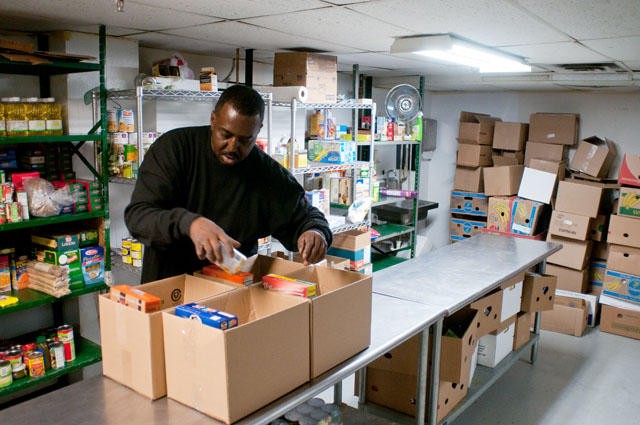Each Thanksgiving, food shelves across the metro area prepare for a rise in hunger during the holidays. With the recession, however, that rise has lasted long after the festivities end, and food shelves are feeling the pressure.
At Keystone Community Services in St. Paul, the number of individuals looking for food has increased by 61 percent in the past year.
âÄúWeâÄôre serving about 1,000 more people per month than we were a year ago,âÄù Christine Pulver, KeystoneâÄôs basic needs program director, said.
At Sabathani Community Center in South Minneapolis, the number of families served each day has doubled, said Sandra Richardson, program manager of family resources. Its food shelf now feeds 60 to 80 families every day.
About 10 people milled about Monday afternoon, waiting for assistance amid the chipping yellow paint of the Sabathani food center, located in the basement of an old middle school.
Cheryl Sully visits Sabathani about once a month. She has a part-time job, but says itâÄôs still not enough.
âÄúAt my job I donâÄôt have insurance or benefits,âÄù she said. âÄúIt would be hard [without Sabathani].âÄù
Many of SabathaniâÄôs clients are individuals who, one year ago, were working and considered middle class, Richardson said.
The story is similar across the entire state. Over the past five years, the number of people participating in food stamps and food support programs has increased by more than 70 percent, according to a report from Hunger Solutions Minnesota, a St. Paul-based advocacy organization.
According to the Food Research and Action Center âÄî a national non-profit working on public policy regarding hunger eradication in the U.S. âÄî data released earlier this year indicates 13.8 percent of people living in Minnesota were not able to afford an adequate amount of food in 2009.
In the first six months of 2010, Twin Cities food shelves served more than 190,000 individuals, according to Hunger Solutions Minnesota.
This sudden increase in the need for food has some experts in the field worried that food centers will not be able to keep up.
âÄúCapacity at food shelves generally is growing, but not at the pace that the hunger problem has,âÄù said Joan Wadkins, spokeswoman for Second Harvest Heartland, a Midwest hunger relief organization.
Wadkins said that the most shocking aspect of the recent growth in hunger is not who, but where. The areas seeing the most growth are not inner city neighborhoods, but suburban areas, Wadkins said.
Volunteers Enlisted to Assist People, a food shelf located in Bloomington, has experienced huge increases in the number of people looking for assistance, director Karin Meier said.
VEAP, which serves approximately 7,000 individuals per month, has been struggling to come up with enough food to meet the demands, Meier said.
Most who work in the industry blame the recession for the recent increases in hunger.
âÄúItâÄôs simply the economy,âÄù said Pulver of why more people are asking for food.
The ongoing recession not only has more people asking for assistance, but has also contributed to the change in clientele. Many shelters in the Twin Cities are serving people from all classes, races and ages.
Hunger is especially prevalent among people that will not, or are not, trying to enter the workforce, Wadkins said.
âÄúWeâÄôve seen a large growth particularly of seniors,âÄù she said. Hunger among elderly has increased 70 percent over two years, she said.
Another large area of growth is among families who could be considered middle class.
Many food shelf clients at VEAP are employed part time, but due to the recession have lost hours and therefore arenâÄôt able to make ends meet, Meier said.
In light of the holiday, Sabathani is working with Minnesota Vikings wide-receiver Bernard Berrian on Tuesday to distribute 50 turkeys to clients at the center. Similar food drives are happening around the metro area.
University senior Luke Aslesen has hosted a Thanksgiving meal drive with his family for as long as he can remember. This year, the drive will provide more than 15,000 meals to hungry families.
Many shelves are hoping for an increase in donations in time for summer, the busiest time of the year.
âÄúSummer is the busiest, because kids are out of school,âÄù Sabathani director Pam Young said. Until then, many centers are barely hanging on.
âÄúWeâÄôre keeping up at this point, but when you talk about an increase of 61 percent [at Keystone], itâÄôs rather difficult,âÄù Pulver said.
Despite the scramble, Richardson says the Center will never turn anyone away.
âÄúWe pray a lot,âÄù she said. âÄúWe pray an awful lot, and [food] always seems to arrive in just the nick of time.âÄù
Even if food does arrive on time, many believe that providing food to the hungry will not ultimately solve the problem.
âÄúI think weâÄôre only a band-aid,âÄù Pulver said. The issue is more employment, better job training and job creation, she said.
People want to work, Richardson said. âÄúI think there is this myth that people come to food shelters to get free food, but which would you rather do?âÄù she said. âÄúCome here, sign up, wait in line, get food, or go to Cub [Foods] and choose what you want?âÄù
âÄúWe will probably see this for a long time,âÄù Meier said. In a recession, âÄúthe low-income population, theyâÄôre the first to feel the pinch and the last to feel the recovery.âÄù









